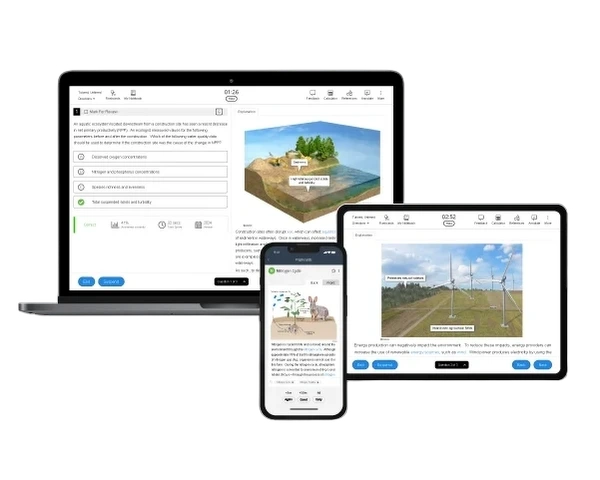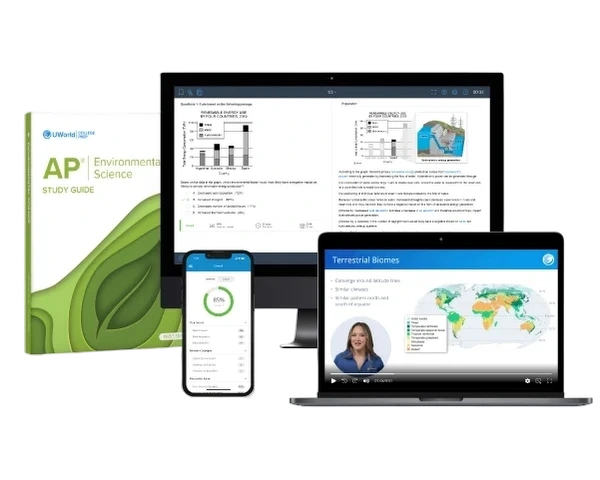The AP® Environmental Science (APES) course is equivalent to a 1-semester introductory college course on the subject. If you’re planning to take the course and exam, it is important to familiarize yourself with its course content.
AP Environmental Science Units, Topics and Key Concepts
The APES course is made up of 2 components:
- Course content
- Science practices
The course is structured into 8 widely taught units, all interconnected by 4 Big Ideas. Additionally, you'll develop proficiency in 7 key science practices as you progress through the units.
AP Environmental Science’s 4 Big Ideas
Big Ideas are the basis of the course and help you make connections between course units and concepts. You can get a deeper understanding of the Big Ideas by applying them in different ways as you go through each unit. The Big Ideas for the course include:
Big Idea 1: Energy Transfer (ENG)
Energy transformations drive all ecological processes. Energy cannot be created. It can only change forms from 1 type to another (eg.: from potential to kinetic energy). As energy passes through systems, more of it is wasted at each step.
Big Idea 2: Interactions between Earth Systems (ERT)
The Earth comprises interconnected biochemical systems that work together to create a stable ecosphere. These systems change over time and space, each with a different threshold for recovering from damage or disturbances.
Big Idea 3: Interactions Between Different Species and the Environment (EIN)
For millions of years, humans have altered Earth’s natural systems, which have had an enormous impact on the environment. The nature and pace of this impact have grown exponentially with the development of technology and population growth.
Big Idea 4: Sustainability (STB)
To survive and thrive, we need sustainable systems. That means finding the perfect balance between conserving and developing resources. Managing our resources wisely is super important. As we work towards developing solutions, we need to understand that cultural, social, and economic factors play a big role in finding solutions.
AP Environmental Science’s 9 Units and Their Topics
While each APES unit is important, some carry more weight — especially in the multiple-choice section — so you'll encounter more questions from these units than others. The table below outlines the units and their respective weights in Section I of the exam.
| Units | Weighting |
|---|---|
| Unit 1: The Living World: Ecosystems | 6-8% |
| Unit 2: The Living World: Biodiversity | 6-8% |
| Unit 3: Populations | 10-15% |
| Unit 4: Earth Systems and Resources | 10-15% |
| Unit 5: Land and Water Use | 10-15% |
| Unit 6: Energy Resources and Consumption | 10-15% |
| Unit 7: Atmospheric Pollution | 7-10% |
| Unit 8: Aquatic and Terrestrial Pollution | 7-10% |
| Unit 9: Global Change | 15-20% |
Learn more about these AP Environmental Science units by clicking on the unit widgets below:
The Living World: Ecosystems | Class Periods: 14-15
The first unit establishes the course's basis by exploring the Earth as a system with interrelated components, processes, and relationships. This unit identifies how resources are spread out in ecosystems and how this affects the way species interact with each other. In this unit, you will study biomes and how environmental circumstances affect organismal relationships. You will learn to quantify energy loss in ecosystems and explain the transfer of energy.
You will learn about the following AP Environmental Science topics:
- Introduction to Ecosystems
- Terrestrial Biomes
- Aquatic Biomes
- The Carbon Cycle
- The Nitrogen Cycle
- The Phosphorus Cycle
- The Hydrologic Cycle
- Primary Productivity
- Trophic Levels
- Energy Flows and the 10% Rule
- Food Chains and Food Webs
The Living World: Biodiversity | Class Periods: 11-12
Biodiversity refers to the variety of genes, species, and habitats. Biodiversity is an important part of ecosystems because it helps keep life going. In this unit, you will be able to explain and describe the ideas and processes of biodiversity concerning the environment. You must know the differences between similar concepts and ideas and explain those differences in writing and person.
You will learn about the following topics:
- Introduction to Biodiversity
- Ecosystem Services
- Island Biogeography
- Ecological Tolerance
- Natural Disruptions to Ecosystems
- Adaptations
- Ecological Succession
Populations | Class Periods: 12-13
Populations within ecosystems evolve over time as a result of numerous variables. This unit explores the connections between the type of species and changes in an ecosystem. You may find it helpful to have multiple chances to practice mathematical calculations such as figuring out population growth and how to use the rule of 70 in this course. You can also work on choosing the right calculation needed to analyze a data set.
You will learn about the following topics:
- Generalist and Specialist Species
- K-selected r-selected Species
- Survivorship Curves
- Carrying Capacity
- Population Growth and Resource Availability
- Age Structure Diagram
- Total Fertility Rate
- Human Population Dynamics
- Demographic Transition
Earth Systems and Resources | Class Periods: 11-12
This unit examines earth systems and life-sustaining resources. Changes to Earth's systems at convergent and divergent boundaries can cause mountains, island arcs, earthquakes, volcanoes, and seafloor spreading. In this unit, you can practice analyzing and understanding qualitative models and representations of environmental issues. You should be able to identify and describe environmental processes that are visibly displayed.
You will learn about the following topics:
- Plate Tectonics
- Soil Formation and Erosion
- Soil Composition and Properties
- Earth's Atmosphere
- Global Wind Patterns
- Watersheds
- Solar Radiation and Earth's Seasons
- Earth's Geography and Climate
- El Nino and La Nina
Land and Water Use | Class Periods: 18-19
This unit explores human activities that disrupt ecosystems in both beneficial and negative ways, as well as the measures used to mitigate their effects. It looks at how people use natural resources, like mining and clear-cutting, and how that affects the environment. In this unit, you can practice naming environmental problems such as pollution, the depletion of the ozone layer, and global climate change.
You will learn about the following topics:
- The Tragedy of the Commons
- Clearcutting
- The Green Revolution
- Impacts of Agricultural Practices
- Irrigation Methods
- Pest Control Methods
- Meat Production Methods
- Impacts of Overfishing
- Impacts of Mining
- Impacts of Urbanization
- Ecological Footprints
Energy Resources and Consumption | Class Periods: 16-17
This unit will analyze the effects human consumption of renewable and nonrenewable energy sources has on the surrounding ecosystem. Energy consumption varies around the world, and the availability of energy resources is determined by the region's geologic history. In this unit, you will learn how to find sources of natural energy resources such as coal, crude oil, and ore on the world map.
You will learn about the following topics:
- Renewable and Non-renewable Resources
- Global Energy Consumption
- Fuel Types and Uses
- Distribution of Natural Energy Resources
- Fossil Fuels
- Nuclear Power
- Energy from Biomass
- Solar Energy
- Hydroelectric Power
- Geothermal Energy
- Hydrogen Fuel Cell
- Wind Energy
- Energy Conservation
Atmospheric Pollution | Class Periods: 11-12
Air is a natural resource that covers the whole planet and flows through many systems. The air quality is affected by what people do both inside and outside. In this unit, you can practice comparing and predicting patterns and/or trends in a graph or table to explain how the data or representation shows environmental concepts. You can also practice finding ways to fix the health problems caused by air pollution.
You will learn about the following topics:
- Introduction to Air Pollution
- Photochemical Smog
- Thermal Inversion
- Atmospheric CO2 and Particulates
- Indoor Air Pollutants
- Reduction of Air Pollutants
- Acid Rain
- Noise Pollution
Aquatic and Terrestrial Pollution | Class Periods: 19-20
Human actions that cause pollution have a direct effect on ecosystems in the air, on land, and in water. Sometimes, it's easy to figure out where pollution comes from, but other times, it's hard to tell. Numerous problems affecting human health have been connected to pollution. You should be able to look at an environmental problem with a critical eye and evaluate a given solution, pointing out its pros and cons.
You will learn about the following topics:
- Sources of Pollution
- Human Impacts on Ecosystems
- Endocrine Disruptors
- Human Impacts on Wetlands and Mangroves
- Eutrophication
- Thermal Pollution
- Persistent Organic Pollutants (POPs)
- Bioaccumulation and Biomagnification
- Solid Waste Disposal
- Waste Reduction Methods
- Sewage Treatment
Global Change | Class Periods: 19-20
A big part of environmental science is figuring out how local and regional human actions affect the world. People can lessen their effects by using resources sustainably. Human actions can deplete the amount of ozone in the stratosphere and raise the amount of greenhouse gases in the air. When greenhouse gases increase, it can hurt people's health and the environment. This final unit will help you describe and explain global environmental changes, their causes, and their implications. As you learn about problems caused by global environmental changes, you can use the skills you learned in previous units, where you described and rated solutions, to develop your own solutions.
You will learn about the following AP Environmental Sicence topics:
- Stratospheric Ozone Depletion
- Reducing Ozone Depletion
- The Greenhouse Effect
- Increase in Greenhouse Gases
- Global Climate Change
- Ocean Warming
- Ocean Acidification
- Invasive Species
- Endangered Species
- Human Impacts on Biodiversity

APES Science Practices
The APES science practices explain the skills you should acquire during the course and be able to execute in the exam. Below are the 7 skill categories you should master by the end of your course. Note that questions on the exam will ask you to solve problems by using 1 or more of these science practices.
Science Practice 1: Concept Explanation
You’ll learn to explore environmental concepts, processes, and models in written form.
You will learn how to:
- Describe and explain environmental concepts and processes in applied contexts.
Science Practice 2: Visual Representations
You’ll learn to explore visual representations of environmental concepts and processes.
You will learn how to:
- Describe and explain how the visual representation of an environmental concept, process, or model relates to broader environmental challenges.
Science Practice 3: Text Analysis
You’ll learn to analyze sources of information about environmental issues.
You will learn how to:
- Define the author's point of view.
- Describe the author's viewpoint, assumptions, and reasoning.
- Analyze the reliability of a source and assess the soundness of a study's findings.
Science Practice 4: Scientific Experiments
You’ll learn how to analyze research studies focusing on environmental principles.
You will learn how to:
- Find a hypothesis or scientific question before conducting an investigation.
- Specify the methodology, design, and/or measurement employed.
- Describe an aspect of the employed study method, design, or measure.
- Observe laboratory settings or collect data from them.
- Describe alterations to a procedure that will affect the results.
Science Practice 5: Data Analysis
You’ll learn to analyze and interpret quantitative data presented in tables, charts, and graphs.
You will learn how to:
- Describe data-based patterns.
- Describe connections between variables represented in data.
- Explain data trends and patterns to draw a conclusion.
- Analyze experimental data and outcomes in light of the specified hypothesis.
- Explain what the evidence suggests or indicates regarding environmental concerns.
Science Practice 6: Mathematical Routines
You’ll learn how to use quantitative methods to talk about ideas about the environment.
You will learn how to:
- Identify a strategy or method that corresponds to the problem to be tackled.
- Utilize relevant mathematical relationships, such as dimension analysis, to solve an issue.
- Calculate a precise numerical answer using the correct units.
Science Practice 7: Environmental Solutions
You’ll learn how to identify solutions to environmental problems.
You will learn how to:
- Describe and explain environmental problems.
- Describe potential solutions or methods for environmental issues.
- Describe downsides, advantages, or unforeseen consequences for suggested solutions.
- Use info and evidence supporting a prospective solution.
- In an applied context, make a claim that provides a remedy to an environmental issue.
- Clarify a suggested solution by describing its potential benefits.
Our comprehensive AP Environmental Science Online course includes a comprehensive study guide and extensive QBank. Engaging videos, expert-crafted practice questions, and a visually rich study guide with step-by-step explanations will boost your score.
Frequently Asked Questions (FAQs)
How many topics are there in AP Environmental Science?
The AP Environmental Science course has 9 units. Each unit is divided into teachable segments known as topics. Each unit has approximately 10 topics.
What are the most important units in AP Environmental Science?
The top 5 units with the most number of questions on the APES MCQ section of the exam can be considered more important than other units. These units are:
- Unit 9: Global Change (15-20%)
- Unit 3: Populations (10-15%)
- Unit 4: Earth Systems and Resources (10-15%)
- Unit 5: Land and Water Use (10-15%)
- Unit 6: Energy Resources and Consumption (10-15%)

References
- AP Environmental Science Course And Exam Description. (2019). apstudents.collegeboard.org. Retrieved on February 27, 2025 from https://apstudents.collegeboard.org/sites/default/files/2019-05/ap-environmental-science-course-and-exam-description.pdf
- Course Content. AP Environmental Science. (2025). apstudents.collegeboard.org. Retrieved on February 27, 2025 from https://apstudents.collegeboard.org/courses/ap-environmental-science
Read More About the AP Environmental Science Exam
Do you want to know the best strategies and the finest resources to score a 5 on the APES exam? Check out our step-by-step plan to score high with ease on the exam.
About AP Environmental Science ExamWhat do you need to know before enrolling in this year's APES exam? As a resource, we've compiled essential exam information and a list of some FAQs you may need.
AP Environmental Science Exam FormatWant to learn about the AP Environmental Science exam format? Here is a breakdown of the APES exam structure including the question types, duration, and more.
AP Environmental Science Score GuideHow is the APES exam scored? Learn how MCQ and FRQ sections contribute to your final AP Environmental Science score and what goes into the grading process.
Best AP Environmental Science Course ReviewFind the Best APES Prep Course! Compare top-rated AP Environmental Science courses with expert insights on content quality, practice questions, and study tools.
AP Environmental Science Study Guide ComparisonBest APES Study Guides Reviewed! Explore top-rated study guides with expert insights on explanations, practice questions, and test-taking strategies.



